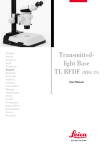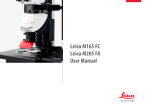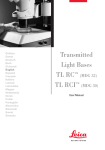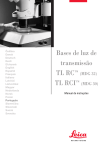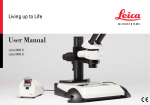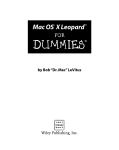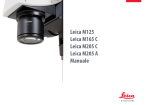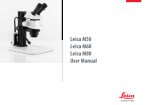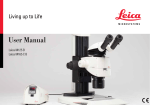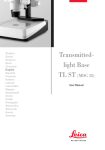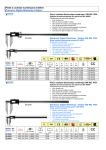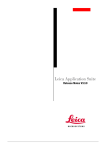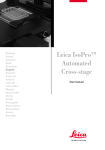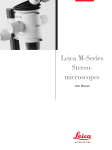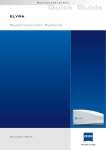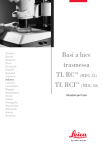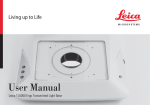Download Leica M125, M165 C, M205 C, M205 A Manual
Transcript
Leica M125
Leica M165 C
Leica M205 C
Leica M205 A
Manual
General Instructions
Safety concept
Before using your microscope for the first time,
please read the "Safety concept" brochure
included with your instrument. It contains additional information about handling and care.
Use in clean rooms
The Leica M series can be used in clean rooms
without any problems.
Cleaning
★★ Do not use any unsuitable cleaning agents,
chemicals or techniques for cleaning.
★★ Never use chemicals to clean colored
surfaces or accessories with rubberized
parts. This could damage the surfaces,
and specimens could be contaminated by
abraded particles.
Servicing
★★ Repairs may only be carried out by Leica
Microsystems-trained service technicians.
Only original Leica Microsystems spare
parts may be used.
Responsibilities of person in charge of
instrument
★★ Ensure that the Leica stereomicroscope
is operated, maintained and repaired by
authorized and trained personnel only.
★★ In most cases, we can provide special solutions on request. Some products can be
modified, and we can offer other accessories for use in clean rooms.
Leica M series
Manual
2
Safety concept
The individual modules of the Leica M stereomicroscopy series include an interactive
CD-ROM with all relevant user manuals in 20
other languages. Keep it in a safe place, and
readily accessible to the user. User manuals and
updates are also available for you to download
and print from our web site at www.stereomicroscopy.com.
This operating manual describes the special
functions of the individual modules of the Leica
M stereomicroscopy series and contains important instructions for their operational safety,
maintenance, and accessories.
You can combine individual system articles
with articles from external suppliers (e.g. cold
light sources, etc.). Please read the user manual
and the safety requirements of the supplier.
Before installing, operating or using the instruments, read the user manuals listed above. In
particular, please observe all safety instructions.
To maintain the unit in its original condition
and to ensure safe operation, the user must
follow the instructions and warnings contained
in these user manuals.
The "Safety concept" booklet contains additional safety information regarding the service
work, requirements and the handling of stereomicroscope, accessories and electrical accessories as well as general safety instructions.
Leica M series
Manual
3
Symbols used
Warning of a danger
This symbol indicates especially important information that must be read and
complied with. Failure to comply can cause the
following:
• ★★ Hazards to personnel
★★ Functional disturbances or damaged instruments
Warning of hazardous electrical voltage
This symbol indicates especially important information that, if not observed,
can cause the following:
★★ Hazards to personnel
★★ Functional disturbances or damaged instruments.
Leica M series
Danger due to hot surface
This symbol warns against touching hot
surfaces, e.g. those of light bulbs.
Important information
This symbol indicates additional information or explanations that intend to
provide clarity.
Action
★★ This symbol refers to actions described in
the text that are to be carried out.
Figures
(1) Numbers in brackets within the descriptions relate to the figures and the items
within those figures.
Manual
4
Safety regulations
Description
The individual modules fulfill the highest
requirements for observation and documentation of Leica stereo microscopes of the
M series.
non-Leica components that are outside of the
scope of this manual.
Requirements for the owner/operator
★★ See “Safety concept” booklet
Unauthorized alterations to the instrument or
noncompliant use shall void all rights to any
warranty claims!
Ensure that:
★★ The M series stereomicroscopes and
accessories are operated, maintained and
repaired by authorized and trained personnel only.
Designated use
★★ See “Safety concept” booklet
Location of use
★★ See “Safety concept” booklet
Non-intended use
★★ See “Safety concept” booklet
★★ Set up the electrical components at least 10
cm from walls and combustible objects.
Never use M series microscopes or their components for surgical procedures (e.g. on the eye)
unless they are specifically intended for that
purpose.
★★ Avoid large temperature fluctuations,
direct sunlight and vibrations. These conditions can distort measurements and micrographic images.
The devices and accessories described in this
operating manual have been tested for safety
and potential hazards. The responsible Leica
affiliate must be consulted whenever the device
is altered, modified or used in conjunction with
★★ In warm and warm-damp climatic zones,
the individual components require special
care in order to prevent the build up of
fungus.
Leica M series
Manual
★★ All operators have read, understood and
observe this user manual, and particularly
the safety instructions.
5
Safety regulations (continued)
Repair, service work
★★ See “Safety concept” booklet
★★ Only original Leica Microsystems spare
parts may be used.
Installation in third-party products
★★ See “Safety concept” booklet
Disposal
★★ See “Safety concept” booklet
★★ Before opening the instruments, switch off
the power and unplug the power cable.
★★ Touching the live circuit can cause injury.
Transport
★★ Use the original packaging for shipping or
transporting the individual modules of the
Leica M stereomicroscopy series and the
accessory components.
Legal regulations
★★ See “Safety concept” booklet
EC Declaration of Conformity
★★ See “Safety concept” booklet
★★ Optimal arrangement of workplace, work
assignments and work flow (changing tasks
frequently).
★★ Thorough training of the personnel, giving
consideration to ergonomic and organizational aspects.
★★ In order to prevent damage from vibrations,
disassemble all moving parts that (according to the user manual) can be assembled
and disassembled by the customer and
pack them separately.
Leica M series
Health risks
Workplaces equipped with stereomicroscopes
facilitate and improve the viewing task, but
they also impose high demands on the eyes
and holding muscles of the user. Depending on
the duration of uninterrupted work, asthenopia
and musculoskeletal problems may occur. For
this reason, appropriate measures for reduction
of the workload must be taken:
The ergonomic design and construction of the
Leica M stereomicroscopy series are intended to
reduce the exertion of the user to a minimum.
Manual
6
Safety regulations (continued)
Direct contact with eyepieces can be a potential
transmission path for bacterial and viral infections of the eye.
The risk can be kept to a minimum by using
personal eyepieces for each individual or
detachable eyecups.
Light sources: safety instructions
Protective measures of the manufacturer:
★★ UV protection screen in front of the specimen plane prevents the user from looking
directly into the UV rays.
★★ Dummy filter carriers in the free positions
of the rapid filter changer prevent direct UV
radiation from reaching the eyes.
★★ UV filters are installed in the observation
beam paths to protect the eyes.
Warning
UV radiation could damage the eyes. Therefore:
★★ Never look into the light spot on the specimen plane without a UV protection screen.
★★ Never look into the eyepieces if no excitation filter is in the beam path.
★★ Fill empty filter positions with dummy filter
carriers (e.g. M165FC).
★★ Do not select a white, strongly reflective
background for the stage.
★★ The stray-light protection on the lamp
housing prevents irradiation of the hands.
Leica M series
Manual
7
Safety regulations (continued)
Supply unit
Always unplug the supply unit from the power
supply:
★★ When installing and disassembling the
lamp housing
★★ Before opening the lamp housing
★★ When replacing the high-pressure mercury
lamp and other parts, such as the heat-absorbing filter or the collector
Lamp housing
★★ Never open the lamp housing while the
lamp is switched on. Risk of explosion, UV
exposure, blinding!
★★ Before opening the lamp housing, allow it
to cool off for at least 15 minutes. Danger
of explosion!
★★ Never cover the air duct on the lamp housing. Danger of fire!
★★ during maintenance work on the supply
unit.
Mercury lamp
★★ Follow the user manual and safety instructions provided by the lamp manufacturer,
and, in particular, the section on how to
proceed if a lamp breaks and releases
mercury.
★★ For transport, remove the mercury lamp,
transport it in its original packaging and
protect moving parts in the lamp housing
using the transport anchors.
★★ To minimize the risk of explosion, replace a
discoloured mercury lamp promptly when
it has reached the end of its rated life (follow
the manufacturer's specifications and the
minute meter on the supply unit).
★★ Leica Microsystems assumes no liability
for damage caused by exploding, incorrectly installed or improperly used mercury
lamps.
Leica M series
Manual
8
Table of Contents
General Instructions
Safety concept
Symbols used
Safety regulations
2
3
4
5
The Leica M Series
Congratulations!
A Step Towards Infinity
The Electronics: Comfort, Convenience and Safety
The Modular Design: Everything is Relative
Maximum Compatibility
On We Go
13
14
15
16
17
18
Assembly
Base and Focusing Column
Optics carrier
Tube
Eyepieces
Objective
Objective Nosepiece – Assembly
Objective Nosepiece – Adjusting Parfocality
AX Carrier – Preparation
AX Carrier – Assembly
Transmitted-light Base TL ST
20
21
22
23
24
25
26
27
28
29
Leica M series
Transmitted-light Base TL BFDF: Before First Use
Transmitted-light Base TL BFDF
TL RC™ / TL RCI™
IsoPro™ Manual Cross-stage: Assembly
IsoPro™ Motorized Cross-stage: Assembly
Cables: Terminals
Cables: Cable Duct
Cables: Diagram
Leica LED5000 MCI™
Leica LED5000 MCI™: Alternative Assembly
Leica LED5000 RL
30
31
32
33
36
40
41
42
43
44
45
Quick Start Guide
The Fastest Route to Success
Overview of an M series Microscope
The Correct Interpupillary Distance
Using the Eyepieces
Focusing
Adjusting the resistance of the focus drive
Changing the magnification (zoom)
Ratchet Steps and Magnification Levels
Parfocality: More Comfort and Convenience for Your Work
Iris Diaphragm
47
48
49
50
51
52
53
54
55
56
Manual
9
Eyepieces
Magnification Factors of the Eyepieces
Health Notes
Dioptric correction
Dioptric Correction and Parfocality
Graticules
58
59
60
61
62
Photography & Video
Photography & Video
Photo tubes and C-mounts
Trinocular video/phototube 50%
Trinocular video/phototube 100%
64
65
66
67
Microscope Carrier
The Microscope Carrier AX
The Objective Nosepiece
69
71
Objectives andoptical accessories
The Different Types of Objectives
Leica M series
73
Bases
Transmitted-light Base TL ST: Controls
Transmitted-light Base TL ST: Operation
Transmitted-light Base TL ST: Lamp Replacement
Transmitted-light Base TL BFDF: Controls
Transmitted-light Base TL BFDF: Operation
TL RC™ / TL RCI™: Controls
TL RCI™: The Deflection Mirror
TL RCI™: Color Intensity and Temperature
TL RC™ / TL RCI™: Operation
TL RCI™: Methods in Transmitted Light
TL RCI™: Relief Images
Using Filters
IsoPro™ (Non-motorized): Controls
IsoPro™ (Motorized): Controls
75
76
77
78
79
80
81
82
83
84
85
87
88
89
System Illumination
Leica LED5000 MCI™
Leica LED5000 RL
91
93
Manual
10
Accessories
Leica PSC Controller
95
Dimensional Drawings
Leica M125 / M165 C
Leica M205 C
Leica LED5000 MCI
Leica LED5000 RL
97
101
104
105
Specifications for the Bases
Transmitted-light Base TL ST
Transmitted-light Base TL BFDF
TL RC™ / TL RCI™
IsoPro™ Motorized XY Stage
107
108
109
110
Appendix
Calculating the Total Magnification and Field of View Diameter
Care, Maintenance, Contact Persons
112
113
Leica M series
Manual
11
The Leica M Series
Leica M series
Manual
12
Congratulations!
Congratulations on obtaining your new Leica M series stereomicroscope.
We are convinced it will exceed your expectations, as never before have
we applied our decades of experience in the areas of optics, mechanical
engineering and ergonomics in such an uncompromising manner.
The M series embodies all the qualities you associate with the name Leica
Microsystems: excellent objectives, high-quality engineering, and reliability. Furthermore, the modular design ensures that the M series adapts
perfectly to your needs—no matter which accessories you require for your
tasks.
Leica M series
Though the reliability and robustness of Leica stereomicroscopes is
legendary, like any high-tech product, the M series requires a certain
degree of care and attention. Therefore, we recommend that you read
this manual. It contains all the information you need regarding operation,
safety and maintenance. Simply observing a few guidelines will ensure
that even after years of intensive use, your stereomicroscope will continue
to work as smoothly and reliably as on the very first day.
We wish you the best of success in your work—after all, you are now
equipped with the best tool!
Manual
13
A Step Towards Infinity
Ever since their introduction by Horatio S.
Greenough, stereomicroscopes have worked
according to the optical principles based
primarily on Ernst Abbe's research. For over a
century, ingenious optics designers and engineers have worked to push magnification, resolution and image fidelity to the limit permitted
by optics.
In doing so, they have always been constrained
by the interrelation between three factors: the
higher a microscope's resolution, the lower the
available working distance. If one increases the
distance of the optical axes, the three-dimensional image seen by the observer becomes
distorted—a sphere becomes an ellipse, a flat
surface curves toward the observer.
Limits are made to be broken.
The Leica M205 C is the world's first stereomicroscope with a zoom range of 20.5:1. This
accomplishment, however, was not enough for
Leica's engineers. With the new FusionOptic™ in
the M205 C, they have succeeded in going yet
another step beyond previous limits. In addition
to the increase in magnification, the resolution,
too, has been increased to up to 1050 lp / mm*,
which corresponds to a resolved structure size
of 472 nm.
Of course, this performance increase benefits
your everyday work. Set up your specimens
on the microscope with comfortable freedom
of movement and discover details in stereomicroscopy that you could never see before.
* Leica M205 C with 1.0× planapochromat and 10× eyepieces
Leica M series
Manual
14
The Electronics: Comfort, Convenience and Safety for your Experiments
Never before have electronics been used as
extensively in a Leica series as in the new
M series. Optics carrier, tripod, base and illuminator are all connected using electrical
contacts—which provides a number of advantages.
Reliability for your experiments
Exact reproducibility of results is an increasingly common demand, particularly in research
and development. The continuous encoding
captures parameters such as the magnification, the illumination, the position of the iris
Contacts not only transmit data, but also supply
the power.
Leica Application Suite (LAS) evaluates the
transmitted data and can restore the test situation later.
Leica M series
Manual
diaphragm and more to the Leica LAS software.
Thus you always know the conditions under
which an image was acquired.
Fewer cables
A large part of the cables have been routed in
the interior of the column. Data are also transferred via the interface between the column,
the optics carrier and the carrier. The direct
result is that you need fewer cables—this not
only makes your workstation neater and more
comfortable, it even makes it appear larger.
15
The Modular Design: Everything is Relative
The Leica M series provides maximum flexibility in choosing equipment, thanks primarily to
the modular configuration and the compatibility that Leica has painstakingly maintained for
decades. The optics carriers, eyepieces, bases
and more can be combined in any way you
choose, allowing you to create the microscope
that best suits your needs.
Leica M series
Despite this, you will notice that the controls
and individual components do not differ significantly. Whichever configuration you choose,
you will quickly feel right at home.
Manual
Have a special request? Let us know!
Leica Microsystems enjoys an exceptional reputation when it comes to devising customerspecific solutions. If you have a special request
that cannot be met with standard parts, contact
your Leica consultant. We have a solution for
every problem.
16
Maximum Compatibility
Leica engineers were careful to ensure that the
new M series—like its predecessors—remains
compatible with existing series. This means
that objectives, bases, tubes and so on can be
reused.
Objectives
All new objectives of the M series are parfocal,
meaning that when used with the objective
nosepiece, they can be replaced while keeping
the specimen in perfect focus.
If you prefer, you can continue to use the previous objective series. In this case, parfocality is
no longer guaranteed.
Leica M series
Tubes
The interface between the optics carrier and the
tube has remained the same, so existing tubes
fit the new M series. The new tubes are designed
for eyepieces with field number 23, while the
predecessor models were only designed for
field number 21, resulting in a smaller object
field.
Eyepieces
However, the new M-series eyepieces models
have an audible and tangible click to provide
immediate feedback in case of accidental
adjustment.
Manual
17
On We Go
If your new Leica microscope has already been
assembled and commissioned by your Leica
consultant, click here to skip through the installation instructions and go directly to the Quick
Start Guide on page 46.
Leica M series
If, on the other hand, you are assembling the
microscope yourself, continue with the "Assembly" chapter, which begins on page 19.
Manual
18
Assembly
Leica M series
Manual
19
Base and Focusing Column
The first step is to connect the focusing column
of the M series to the corresponding base.
Assembling the column adapter
1. Securely install the column adapter on the
column using the four included screws.
Assembling the focusing drive
2. Securely screw the focusing column to the
base using the six included screws.
Tools used
★★ Hex socket screwdriver, 3 mm
Leica M series
Manual
20
Optics carrier
Tools used
★★ Hex socket screwdriver, 4 mm
Leica M series
Assembling the optics carrier
1. Place the optics carrier on the focusing
column so that the screw fit into the thread
provided and the lug fits into the groove.
Manual
2. Press the optics carrier backwards to the
focusing column and screw it in place using
your other hand.
21
Tube
All intermediate tubes that fit between the
optics carrier and the binocular tube are fitted
in the same manner.
Tools used
★★ No tools required.
Assembling the tube
2. Push the tube (for example, the inclined
binocular tube) into the dovetail ring and
rotate it slightly in both directions until the
positioning screw meshes with the guide
groove.
3. While holding the tube only slightly, carefully tighten the positioning screw. It
is automatically brought to the correct
position.
Preparations
1. Unscrew the positioning screw and remove
the protective cover.
Leica M series
Manual
22
Eyepieces
Tools used
★★ No tools required.
Magnification range
You can extend the overall magnification range
using available 10×, 16×, 25× and 40× widefield eyepieces for persons wearing glasses.
Preparation
1. If you want to use an optional graticule,
insert it now (page 62).
Inserting the eyepieces
3. Push the eyepieces into the tubes as far as
they will go and check to ensure that they
fit tightly and accurately.
2. Remove the plastic tube guard.
4. Securely tighten the clamping screws.
Leica M series
Manual
23
Objective
Tools used
★★ No tools required.
Preparation
1. Remove the protective cap on the optics
carrier by turning it.
Attaching the objective
Hold the objective firmly during assembly and disassembly so that it does not
fall onto the stage plate. This applies particularly to the 2× planapochromatic objective,
which is very heavy. Remove all specimens from
the stage plate first.
•
Alternative fastening options
★★ If using the objective nosepiece, read the
instructions on page 25.
★★ If using the AX carrier, read the instructions
on page 27.
2. Screw the objective clockwise into the
optics carrier.
Leica M series
Manual
24
Objective Nosepiece – Assembly
Preparations
Hold the objectives firmly during
assembly and disassembly so that they
do not fall onto the stage plate.
•
2. Rotate the moving part by 90° and attach
the objective nosepiece to the drive housing from the front (!). Screw the objective
nosepiece firmly into place.
★★ Move the drive housing all the way upwards
and remove the optics carrier, if the carrier
has already been installed.
Assembly
1. Remove the transport anchor from the
objective nosepiece.
4. Screw the optics carrier onto the objective
nosepiece.
5. Screw both objectives onto the objective
nosepiece. It makes no difference which
position an objective occupies.
6. Unscrew the locking screws on both sides
of the objective nosepiece.
3. Unscrew the three Phillips screws on the
objective mount of the optics carrier and
remove the intermediate ring.
You can now adjust the parfocality (see instructions on the next page).
Leica M series
Manual
25
Objective Nosepiece – Adjusting Parfocality
The following procedure only has to be carried
out once. Afterwards, both objectives are parfocal, meaning that the specimen remains in focus
when the objective nosepiece is rotated.
Adjustment
1. Rotate the 2× objective into the beam path
and set it to the lowest magnification.
2. Focus on the specimen.
This procedure must be repeated if you replace
either of the two objectives with another.
The following example assumes the combination of the 1× and 2× planapochromats. If
you are using another objective combination,
replace the 2× objective in the description with
the objective with the stronger magnification.
3. Rotate the 1× objective into the beam
path.
4. Turn the objective on the thread in both
directions until the specimen appears
sharp.
7. Toggle to the 1× objective.
8. Turn the objective on the thread in both
directions until the specimen appears
absolutely sharp.
By means of zooming, check that the behavior
of the objective is parfocal. Repeat the check
with the other objective. If it is not parfocal,
repeat the procedure.
9. Tighten the locking screws.
5. Toggle to the 2× objective.
Preparation
★★ Open the iris diaphragm.
6. Select the strongest magnification and
refocus until the specimen appears absolutely sharp.
★★ Set the dioptric correction of the eyepieces
to "0".
Leica M series
Manual
26
AX Carrier – Preparation
Tools
★★ Hex socket screwdriver, 2.5 mm
★★ If the switch position corresponds to the
optics carrier used, skip the following steps.
Otherwise, proceed as follows:
Preparing the AX carrier
Before the AX carrier is installed, it may first
have to be prepared for the optics carrier to be
used (Leica M125, M205 C or M165 C).
2. Unscrew the two screws that hold the
switch in position.
4. Important: push the switch all the way into
the mount while reinserting the screws.
Only this ensures that the switch is positioned correctly.
1. Check the switch position.
3. Pull out the switch, rotate it into the desired
position and reinsert it.
Leica M series
Manual
27
AX Carrier – Assembly
Tools
★★ Hex socket screwdriver, 4 mm
★★ Philips screwdriver
2. Install the AX carrier on the focusing
column.
4. Unscrew the three holding screws and
remove the adapter ring on the optics
carrier.
Once the AX carrier has prepared for the corresponding optics carrier, it can be installed.
1. Move the slide of the AX carrier into mid
position.
3. Screw the objective to the AX carrier.
5. Install the optics carrier on the AX carrier.
Wrong
Leica M series
Right
Manual
28
Transmitted-light Base TL ST
Unpacking the base
The base is delivered with the adapter plate
installed. Make sure the devices are unpacked
on a flat, sufficiently dimensioned, and non-slip
surface.
Leica M series
Focusing drive and column
1. Unscrew the extension plate from the base
using the Allen key provided.
2. Attach your focusing drive column to the
bottom using the 4 Allen screws.
3. Reattach the adapter plate to its original
position using the 6 Allen screws.
Manual
29
Transmitted-light Base TL BFDF: Before First Use
Removing the transport anchors
Before you can use the transmittedlight base for the first time, it is absolutely necessary to remove the two transport
anchors as follows.
•
Anchor of mirror
Anchor of switching slide
Leica M series
Manual
30
Transmitted-light Base TL BFDF
Standard delivery
The base is delivered with the adapter plate
installed. The selected stage (IsoPro™ crossstage or standard stage 10 447 269), and the
focusing drive will have to be mounted later.
Stage assembly
The TL BFDF transmitted-light base can be
equipped with three different stages.
The selected stage is mounted on the base
before commissioning. You can switch between
the stages at any time with just a few hand
movements.
The following paragraph assumes use of the
base without the stage mounted. Disassembly
is performed in reverse order of the following
steps.
★★ Leica IsoPro™ manual cross-stage
★★ Leica IsoPro™ automatic cross-stage
★★ Standard stage 10 447 269
Leica M series
Standard stage
1. Take the glass plate from the rectangular
gap in the standard stage.
2. Position the stage on the transmitted-light
base in such way that the four holes align
over those in the base.
3. Attach the stage to the base using the four
Allen screws provided.
4. Insert the glass plate back into the standard
stage.
Manual
31
TL RC™ / TL RCI™
The base is delivered with the adapter plate
installed. The selected stage (IsoPro™ crossstage or standard stage 10 447 269), and the
focusing drive will have to be mounted later.
Ensure that the instruments are unpacked on a
level, adequately sized, and nonskid underlay.
Stage assembly
The transmitted-light base TL RC™/ RCI™ can
be equipped with three different stages. The
selected stage is mounted on the base before
commissioning. You can switch between the
stages at any time with just a few hand movements.
Standard stage
1. Take the glass plate from the rectangular
gap in the standard stage.
2. Position the stage on the transmitted-light
base in such way that the four holes align
over those in the base.
3. Attach the stage to the base using the four
Allen screws provided.
4. Insert the glass plate back into the standard
stage.
The following paragraph assumes use of the
base without the stage mounted. Disassembly
is performed in reverse order of the following
steps.
Leica M series
Manual
32
IsoPro™ Manual Cross-stage: Assembly
IsoPro™ Cross-stage
Before the IsoPro™ cross-stage is mounted to
the base, the axis containing the control buttons
is attached either on the left or the right side of
the cross-stage.
Before the IsoPro™ cross-stage is mounted to
the base, the axis containing the control buttons
is attached either on the left or the right side of
the cross-stage.
Left or right operation
If the controls are to be mounted on the lefthand side, the gear rod on the bottom side of
the cross-stage must be unscrewed and reattached in reverse.
If the controls are to be mounted on the lefthand side, the gear rod on the bottom side of
the cross-stage must be unscrewed and reattached in reverse.
1. Take the glass plate from the cross-stage.
2. Turn the cross-stage around and place it
onto a non-slip surface.
3. Change the gear rod from the left to the
right-hand side.
4. Skip the next two steps to mount the
controls.
Leica M series
Manual
33
IsoPro™ Manual Cross-stage: Assembly (continued)
1. Take the glass plate from the cross-stage
and turn it around.
2. Change the gear rod from the left to the
right-hand side.
Control assembly
1. Take the glass plate from the cross-stage
and turn it around.
2. Attach the axis with the control buttons to
the desired side. The fastener snaps into the
cross-stage magnetically.
Cross-stage assembly
1. Place the cross-stage on the base.
2. Pull the upper part of the cross-stage carefully toward the user, fastening the lower
part onto the transmitted-light base.
4. Attach the axis with the two Allen screws
provided.
5. Attach the cover rail to the cross-stage.
Leica M series
Manual
34
IsoPro™ Manual Cross-stage: Assembly (continued)
3. Screw the cross-stage evenly onto the three
threaded holes.
4. Push the cross-stage all the way back
towards the column.
5. Reinsert the glass plate back into the standard stage.
Leica M series
Focusing drive and column
1. Unscrew the extension plate from the base
using the Allen key provided.
2. Attach your focusing drive column to the
bottom using the three Allen screws.
3. Reattach the adapter plate to its original
position using the three Allen screws.
Manual
35
IsoPro™ Motorized Cross-stage: Assembly
Basics
The transmitted light bases of the TL series
(TL BFDF, TL RC™, TL RCI™) are supplied with
an installed extension plate. The selected
stage (IsoPro™ cross-stage or standard stage
10 447 269), and the focusing drive will have to
be mounted later.
1. Unpack the cross-stage from the transport
packaging and position it on the transmitted-light base.
1
The motorized cross-stage is a sensitive precision instrument. During installation, avoid
subjecting the stage to impact or severe vibrations.
2
1 Microscope base
2 Motorized cross-stage
Leica M series
2. Secure the motorized cross-stage to the
base using 3 M4 screws.
Manual
3× M4 screws
36
IsoPro™ Motorized Cross-stage: Assembly (continued)
3. Remove the two M3 screws and the holder
from the cross-stage.
4. Remove the two M4 screws and the sleeve
from the cross-stage.
5. Remove the four shock-absorbing cartons
from the cross-stage.
port
After removal, keep all the transanchors in the plastic bag
for future transport.
Leica M series
Manual
37
IsoPro™ Motorized Cross-stage: Assembly (continued)
The bases
The TL BFDF, TL RC™ and RCI™ transmitted light
bases can be equipped with three different
stages: standard stage, manual and IsoPro™
automated cross-stage. The selected stage is
mounted on the base before commissioning.
You can switch between the stages at any time
with just a few hand movements.
The following paragraph assumes use of the
base without the stage mounted. Disassembly
is performed in reverse order of the following
steps.
Cross-stage and base
Never move the sledge of the motorized
cross-stage manually in the X direction,
as otherwise the mechanical system will be
damaged!
•
1. Place the cross-stage on the base.
2. Pull the upper part of the cross-stage carefully toward the user, fastening the lower
part onto the transmitted-light base.
3. Screw the cross-stage evenly onto the three
threaded holes.
4. Push the cross-stage all the way back
towards the column.
5. Reinsert the glass plate back into the standard stage.
Leica M series
Manual
38
IsoPro™ Motorized Cross-stage: Assembly (continued)
Cross-stage for X-Y Stage Control Module
1. Plug the CTL2 plug of the cross-stage motor
into one of the three available CTL2 interfaces.
As soon as all instruments have been plugged
into the control box and it has been plugged
into the power supply, the cross-stage initializes
and automatically drives to the mid position.
2. Plug the CTL2 plug of the Leica PSC controller into another CTL2 interface.
4. Connect the PC and X-Y Stage DCI Module
(with a suitable USB cable).
★★ The third CTL2 interface is available for
connecting other instruments, such as the
Leica foot switch (10 447 398) or TL RCI™
transmitted light base (10 446 352).
★★ The 15-pin Sub-D interface is intended for
use with the Leica SmartMove™ controller
(11 501 197).
3. Plug a power cable into the socket provided
and into a grounded power socket.
Leica M series
Manual
39
Cables: Terminals
The new Leica M-series features extensive
encoding with which various microscope data
and settings can be read out, transferred to the
PC and reproduced later.
★★ The interface to the optics carrier is on the
column.
The Terminals
The connection to the PC and to other instruments is made using the terminals on the rear
side of the column:
1
3
2
1. 2×CTL2 terminals for auxiliary equipment
such as the ring illuminator, the base and
other accessories from the Leica product
range.
2. Terminal for the 50-watt power supply
provided.
3. USB terminal for the connection to the PC.
Leica M series
Manual
40
Cables: Cable Duct
The integrated cable duct in the column enables
a neat cable layout around the microscope.
For example, the USB or FireWire cables of the
camera can be stowed in the cable duct.
Feeding the cables
1. Unscrew the three screws on the cable
duct.
2. Remove the cover of the cable duct.
Leica M series
Manual
3. Place the cables in the cable duct and screw
the cover on tightly.
Tip: Estimate the length of the cable ends you
will need before screwing on the cover. For
thick cables, it is difficult to change the length
retroactively.
41
Cables: Diagram
Alternative installation
Please use the Leica Application
Suite to configure the functions
of the system.
LED5000 RL
LED5000 MCI™
115/230 V
115/230 V
DCI Controlbox
Power/USB
115/230 V
Footswitch 2...
Footswitch 1
(Connect to free CTL2-port on last footswitch.)
Leica M series
TL RCI™
PC USB
Smart Move
Manual
PSC
Connector from Cross Stage
42
Leica LED5000 MCI™
The Leica LED5000 MCI™ (for "Multi Contrast
Illumination") is installed using two screws. For
optimum accessibility, the optics carrier should
be removed during installation (see page 15.)
Assembly
1. Hold the LED5000 MCI™ with one
hand and tightly screw the retraining
stirrups on both top holes on the drive housing.
• 2. Connect the CAN-bus cable to either of the
two sockets. (The flat part of the plug must
be facing downwards.)
3. Plug the other end of the cable into one of
the two "CTL2" sockets on the column.
Constraints
The Leica LED5000 MCI™ cannot be used
together with the objective nosepiece.
Leica M series
Manual
43
Leica LED5000 MCI™: Alternative Assembly
Under certain circumstances, the light source
must not be moved along with the optics
carrier. A typical example is multifocus images
in which the Z-stack changes while the angle
of incidence of the light must remain the same.
For such purposes, the Leica LED5000 MCI™ is
directly fastened to the column.
2. Screw the retaining stirrup into the column
at the notch using the single screw. If you
tighten the screw, the retaining stirrup is
automatically moved into the correct position.
3. Push the Leica LED5000 MCI™ onto the
retaining stirrup.
Installation on the column
1. Pull the retaining stirrup out of the Leica
LED5000 MCI™.
Leica M series
Manual
44
Leica LED5000 RL
The ring illuminator, the Leica LED5000 RL
("Ring Light"), is installed on the objective using
a single screw. It has been optimized for a working distance between 60 and 70 mm.
Constraints
The Leica LED5000 RL can be used in conjunction with the planapochromat 1× and planapochromat 0.63× objectives. With all other
objectives, the working distance is too low for
adequate illumination.
Assembly
1. Connect the CAN-bus cable to the
ring illuminator. The flat part of the plug
must be facing upwards.
• one of the two "CTL2" sockets on the
• objective as far as it will go and screw it
For optimum accessibility of the specimen,
the ring illuminator should be installed with
the cable facing backwards. However, it is also
possible to turn the ring illuminator sideways,
for example if simultaneously using the Leica
LED5000 MCI™ system illumination. In this
case, the ring illuminator cannot be connected
directly to the Leica LED5000 MCI™.
• 2. Push the ring illuminator over the
into place.
The ring illuminator cannot be used together
with the objective nosepiece.
Leica M series
Manual
3. Plug the other end of the cable into
column.
45
Quick Start Guide
Leica M series
Manual
46
The Fastest Route to Success
Your Leica stereomicroscope has been delivered in completely assembled
condition by your Leica partner, and naturally you want to get right to
work. Therefore, your next step should be to study the Quick Start Guide,
which outlines the most important steps at a glance.
This manual will then familiarize you with the finer details of your microscope. The following pages contain important, practical information that
makes using it every day easier.
Take time to read it – it's worth it!
The M series Quick Start Guide (included with instrument).
Leica M series
Manual
47
Overview of an M series Microscope
Click an entry or a position on the microscope to go directly to the corresponding part of the manual.
1
2
3
4
5
6
7
8
9
10
Magnification changer (zoom)
Switch click stops on/off
Coarse/fine focusing
Fastening screw for the binocular tube
(or accessories)
Interchangeable objective
Adjustable eyepiece tubes
Eyepieces for spectacle wearers with dioptric
correction and eyecups
Fastening screws for the eyepieces
Trinocular tube
Built-in iris diaphragm
7
6
9
8
4
2
1
11
10
3
5
Leica M series
Manual
48
The Correct Interpupillary Distance
The interpupillary distance is correctly set if you
see a single circular image field when looking
at a specimen.
If you are still a novice microscope user, you
may need a short time to become accustomed
to this. Not to worry—after a little while, it will
become automatic.
Adjusting the Interpupillary Distance
1. Look into the eyepieces.
3. Slowly approach the eyepieces with your
eyes until you can see the complete image
field without corner cutting.
2. Hold the eyepieces with both hands. Push
the eyepieces together or separate them
until you see a circular image.
Reference value
The distance between eye and eyepiece
measures approx. 22 mm for 10/23B wide-field
eyepieces for persons wearing glasses.
✗
Leica M series
Manual
✓
49
Using the Eyepieces
The eyepieces form the connection between
the tube and the eye of the observer. Simply
push them into the tube and they are ready to
use.
If you do not wear glasses:
1. Hold the eyepiece firmly and rotate the
eyecups forwards counterclockwise.
2. If an eyepiece is equipped with the inte-
If you wear glasses:
1. Hold the eyepiece firmly and rotate the
eyecups counterclockwise towards the rear,
as otherwise the viewing distance is too
great.
Each eyepiece offers a certain magnification
factor that has a determinative effect on the
total magnification. Furthermore, all Leica
eyepieces can be equipped with practical graticules that enable measuring and quantifying of
specimens.
Dioptric correction
A built-in dioptric correction is available for
eyeglass wearers. For more information, refer
to page 60.
grated dioptric correction, turn the value to
the "0" mark.
2. If an eyepiece is equipped with the integrated dioptric correction, turn the value to
the "0" mark.
By the way, one benefit of viewing with
eyeglasses is a drastically lower risk of bacterial transmission (see page 59). The soft material of the eyecup also ensures that your glasses
will not be scratched, even if they contact the
eyepiece.
Leica M series
Manual
50
Focusing
Focusing raises or lowers the stereomicroscope
using the focusing drive. The specimen detail is
brought into sharp focus as soon as it is in the
focal point of the objective.
★★ The focusing drive can be operated either
left- or right-handed.
Focusing
★★ The inner, coarse adjustment is used for
covering great distances.
Coarse/fine adjustment
The sharpness is adjusted using the coarse/fine
adjustment.
★★ The outer, fine adjustment is used for fine
focusing.
• load of up to 15 kg.
The coarse/fine adjustment carries a
★★ The resolution of the coarse/fine adjustment is 1 µm.
Leica M series
Manual
51
Adjusting the resistance of the focus drive
Adjusting the resistance
Is the focus movement too loose or too tight?
Does the outfit tend to slide downwards? The
resistance can be adjusted individually depending on the equipment weight and personal
preferences as follows:
1. Grip the outer drive knobs with both hands
and turn them towards each other until the
desired resistance is reached during focusing.
Leica M series
Manual
52
Changing the magnification (zoom)
All M series microscopes have an integrated
zoom. The name indicates the zoom range
covered:
Zooming
1. Look into the eyepieces.
2. Focus on the specimen.
★★ Leica M125 = 16.5:1
★★ Leica M165 C = 16.5:1
★★ Leica M205 C = 20.5:1
3. Rotate the magnification changer until the
desired magnification is configured.
The rotary knob for the zoom can be used either
left or right-handed.
Leica M series
Manual
53
Ratchet Steps and Magnification Levels
The zoom button can optionally be operated
either with or without ratchet steps. Continuous zoom is possible when the ratchet steps are
disabled, which many users find convenient.
On the other hand, when the ratchet steps are
enabled, photographs, measurement results
etc. can be reproduced more accurately.
Leica M series
Enabling and disabling ratchet steps
1. Push the top button downwards to disable
the ratchet steps.
2. Push the bottom button upwards to enable
the ratchet steps.
Manual
Magnifications and
fields of view
The formula on page 112 provide additional
information about the magnifications and field
of view diameters, with consideration given to
the position of the magnification changer and
the eyepiece and objective combination used.
54
Parfocality: More Comfort and Convenience for Your Work
All Leica stereomicroscopes are parfocally
matched, meaning that you can view a focused
specimen from the lowest to the highest magnification without having to refocus. There is no
need to readjust the focus to view of specimen
location that is located higher or lower.
Requirements for parfocal work
★★ If you are using an eyepiece with dioptric
correction, the procedure differs from this
description. For more information, refer to
page 61.
Parfocality
1. Enlarge the view to the maximum level.
2. Focus on the specimen.
You are done! Even if you select a smaller working distance, the specimen remains pin-sharp.
The parfocality is maintained until you focus on
another level of the specimen.
★★ For the procedure for adjusting the parfocality for the objective revolver, refer to
page 26.
Leica M series
Manual
55
Iris Diaphragm
The iris diaphragm in the optics carrier of your
M series microscope has the same purpose as
those in a camera shutter: it regulates the available light, which changes the depth of field. The
"depth of field" is the area of a specimen that is
brought into sharp focus.
Leica M series
Closing the iris diaphragm
★★ Close the iris diaphragm by turning the
knob to the left. The subject appears darker
and the depth of field increases.
Manual
Opening the Iris Diaphragm
★★ Open the iris diaphragm by turning the
knob to the right. The subject now appears
brighter, but the depth of field decreases.
56
Eyepieces
Leica M series
Manual
57
Magnification Factors of the Eyepieces
An eyepiece not only makes it possible to look passively into the microscope, but also has a critical effect on the maximum magnification. The
magnification factor is between 10x and 40x.
The following eyepieces are available for the M series:
Magnification
Dioptric correction
Order number
10×
± 5 diopter settings
10 450 023
16×
± 5 diopter settings
10 450 024
25×
± 5 diopter settings
10 450 025
40×
± 5 diopter settings
10 450 026
Leica M series
Manual
58
Health Notes
Potential sources of infection
Direct contact with eyepieces is a
potential transmission method for
bacterial and viral infections of the eye. The risk
can be kept to a minimum by using individual
eyepieces or detachable eyecups. Eyecups can
be ordered separately. Please contact your
Leica partner.
•
Separate eyecups are an effective way of
preventing infections.
Leica M series
Manual
59
Dioptric correction
All Leica eyepieces are also available with
built-in dioptric correction, allowing the microscope to be used without glasses even by those
with vision problems. The correction comprises
±5 diopter settings.
Using the Dioptric Correction
1. Set the dioptric correction of both eyepieces
to the mid position ("0" diopter settings.
2. While wearing your glasses, look through
the eyepieces and focus on the specimen.
the advantage of parfocality is lost—thus
Note that when using dioptric correction,
you have to manually refocus each time you
change the zoom level. To also use parfocality
with dioptric correction, refer to the instructions on page 61.
3. Rotate both eyepieces to the maximum
value of "+5".
4. Hold one eye closed and rotate the other
eyepiece in "-" direction until the specimen
appears sharp.
5. Then, open the other eye and correct the
diopter settings until the image is uniformly
sharp.
Leica M series
Manual
60
Dioptric Correction and Parfocality
Leica stereomicroscopes are parfocally matched.
The prerequisite for this is the correct setting of
the diopters and the parfocality. The following
adjustments only have to be carried out once
by each user.
Adjusting
1. Set the dioptric correction for both
eyepieces to "0".
Preparations
★★ Move the lever of the video/phototube to
the "observation" position and open the
diaphragm.
3. Select the highest magnification and readjust the sharpness.
★★ If you are using the microscope carrier AX,
set it to stereoscopic observation.
Leica M series
2. Select the lowest magnification and focus
on a flat specimen.
4. Select the lowest magnification again, but
do not look into the eyepieces.
7. Look into the eyepieces.
8. Slowly rotate each eyepiece individually
in the "–" direction until each eye sees the
object sharply imaged.
9. Select the highest magnification and refocus if necessary.
Now, if you adjust the magnification from the
lowest to the highest level, the specimen is
always brought into sharp focus. If not, repeat
the process.
6. Rotate the eyepieces counterclockwise in
the "+" direction as far as they will go (+5
diopter settings).
Manual
61
Graticules
Use
Graticules make length measurements and
counting easier, particularly for workstations
that are not equipped with a digital camera and
LAS software.
2. Clamp the graticule on the insert, applying
moderate pressure. Ensure that the graticule fits tightly.
4. You can now align the graticule by rotating
the eyepiece in the tube and then tightening it using the clamping screw.
The graticules for length measurements and
numbering are fitted in mounts and are inserted
into the eyepieces.
1. Screw the insert off of the eyepiece.
3. Screw the insert and graticule firmly into
place and replace the eyepiece in the tube.
Use with the AX carrier
If possible, measure with the microscope carrier AX in vertical position. The
measurements are more accurate without the
convergence angle in the stereoscopic image.
Leica M series
Manual
62
Photography & Video
Leica M series
Manual
63
Photography & Video
For most microscope users, digital documentation has become an invaluable part of their
work. Research results can be presented in an
attractive manner; measurements on the digital image provide clarity and, in conjunction
with the motorized IsoPro™ cross-stage, even
images of large specimens can be captured
step by step and automatically joined to create
a new complete image.
Leica DFC cameras
However, if you require absolute control
over the camera and need the capability for
measurement, evaluation and more in addition
to photography, the digital Leica DFC cameras
are exactly right for you. Together with the
Leica Application Suite, they provide virtually
limitless freedom of use. For additional information about Leica cameras, refer to the camera's
documentation.
Leica Application Suite
The "Leica Application Suite", or "LAS" for
short, is, as it were, the digital extension of the
Leica M series microscopes. In addition to
capturing images, it lets you control the microscope, illuminator, stages, cameras and more.
For additional information, refer to the LAS
online help.
Adapter
If camera control using the Leica Application
Suite is not required, conventional mirror reflex
and rangefinder cameras from third-party
manufacturers can be used. For this purpose,
Leica Microsystems offers a variety of adapters
that can be used together with the 50% and
100% trinocular tubes.
Leica M series
Manual
64
Photo tubes and C-mounts
Application
All Leica DFC cameras are equipped with a
standardized C-mount interface. In turn, the
C-mount adapter for the respective trinocular
tube is connected to this interface. This adapter
creates a solid mechanical connection between
the microscope and camera and ensures optimum rendering of the microscopic image on
the image sensor of the camera.
Usually, the ideal is for the digital camera to
capture as much of the field of vision as possible, while excluding as much of the black edge
of the field of vision as possible. To do so, the
magnification factor of the C-mount adapter
must match the image format of the sensor as
closely as possible (see table).
Leica M series
If there is unwanted shading at the corners even
with a compatible C-mount adapter installed, it
can be corrected using the "Shading function"
of the camera software.
Alternatively, you can also use a C-mount
adapter with higher magnification. This primarily avoids the critical border area of the field of
vision and concentrates on the center of the
field of vision.
Camera
DFC290
optimal
(large
image field)
suitable
(smaller
image field)
0.5×
0.63×
DFC420
0.5×
0.63×
DFC490
0.63×
0.8×
DFC500
0.63×
0.8×
Manual
Cameras from third-party suppliers
In addition to Leica DFC cameras with the standardized C-mount interfaces, you can connect
third-party cameras to the microscope using
a T2 bayonet adapter. To do so, instead of the
C-mount adapter, simply use the corresponding SLR adapter with T2 connection. However,
these third-party cameras are not integrated
into the Leica Application Suite and have to
be operated using the corresponding software
from the camera manufacturer.
The Leica digital cameras are detailed in a separate user manual along with instructions for
their assembly and use.
65
Trinocular video/phototube 50%
Use
With its third beam path, the trinocular video/
phototube 50% enables you to simultaneously
view and photograph a specimen. The available
light is divided as follows:
★★ 50% is available for the two eyepieces.
★★ 50% of the light is diverted to the video/
photo beam path.
Assembly
Fasten the "trinocular tube 50%" to the optics
carrier instead of the binocular observation
tube (refer to page 22).
Leica M series
Manual
66
Trinocular video/phototube 100%
Use
With its third beam path, the trinocular video/
phototube 100% enables you to either view or
photograph a specimen. This means that 100%
of the light is available to one or the other beam
path. The other beam path remains opaque or
black.
Assembly
Fasten the "trinocular tube 100%" to the optics
carrier instead of the binocular observation
tube (refer to page 22).
Leica M series
Switchover
★★ Turn the controller on the right side of the
tube into the horizontal position in order to
guide all available light into the eyepieces.
You can now observe the specimen.
★★ Turn the controller on the right side of the
tube into the vertical position in order to
guide all available light into the camera.
You can now photograph the specimen.
Manual
67
Microscope Carrier
Leica M series
Manual
68
The Microscope Carrier AX
Users who intend to do a great deal of photography, take measurements or work with polarization should select the microscope carrier AX
for stereoscopic/axial observation. The parallaxfree imaging by means of a perpendicular beam
path leads to results without parallax error.
Stereoscopic viewing
A stereoscopic view is required for examining
spatial objects. For this purpose, the microscope carrier AX must be brought to its home
position.
1. Unscrew the clamping screw.
Compatibility
The planachromatic and planapochromatic
objectives fit into the thread in the microscope
carrier AX for the Leica M125, Leica 165 C and the
Leica M205 C.
2. Push the microscope into the home position (mid position) to obtain a spatial view
and tighten the clamping screw.
Leica M series
Manual
69
The Microscope Carrier AX (continued)
Parallax-free images
The parallax-free imaging produces more
precise results in photography, measuring and
polarization.
1. Unscrew the clamping screw.
2. Push the microscope towards the left as
far as it will go and tighten the clamping
screw.
Leica M series
The objective is now located directly beneath
either the left or the right beam path.
Coaxial light and the Leica M205 C
When using coaxial incident light together with
the Leica M205 C, unscrew the clamping screw
and press the optics carrier towards the right
(caution: the movement is only 2 mm). This
provides uniform light intensity in both beam
paths.
Manual
70
The Objective Nosepiece
Use
The objective nosepiece enables you to switch
between two objectives using just one hand
movement, for example between a 1× and a 2×
planapochromat.
Parfocal work
With the new M series objectives, the parfocality is maintained even when objectives are
changed, meaning that the specimen remains
in sharp focus during the change.
Technical constraints
The objective nosepiece cannot be
used together with the LED5000 MCI™
system illumination, as the objective nosepiece
can no longer be rotated.
•
used, but without parfocality during the
Older Leica objectives can continue to be
objective change.
Leica M series
Manual
71
Objectives and
optical accessories
Leica M series
Manual
72
The Different Types of Objectives
To meet the various requirements regarding
imaging properties, there is a choice of highquality interchangeable planachromatic and
planapochromatic objectives and also lowerpriced interchangeable achromatic objectives.
★★ Achromatic objectives are particularly
suited for specimens with high-contrast
structures.
★★ Flat-field (planachromatic) objectives are
particularly well suited for studying flat
objects such as wafers and thin sections.
Achromatic objectives
The 0.32×, 0.5×, 0.63×, 0.8×, 1×, 1.5×, 2×
achromatic objectives offer countless variants
for selecting the object field diameter, magnification ranges and working distances (see
page 112).
Achromatic objectives with a long focal
length:
For special applications achromatic objectives
with long working distances and focal lengths
of f=100 mm to 400 mm are available.
Planachromatic objective 1×
For the highest requirements for overall image
quality, we recommend equipping the microscope with the 1× plan (flat-field) objective,
which returns sharp, contrast-rich object fields.
★★ With planapochromatic objectives, the
finest structures are visible with high
contrast. The sophisticated apochromatic
correction allows these objectives to attain
the highest color brilliance and fidelity.
Leica M series
Manual
73
Bases
Leica M series
Manual
74
Transmitted-light Base TL ST: Controls
1
2
1
3
4
3
Extension plate of the Transmitted-light Base TL ST
Rear side of the transmitted-light base TL ST
1 Screws for changing the halogen lamp
2 Power connection socket
3 Power switch
1 Adapter plate for easy assembly of focusing
drives
2 Removable glass plate
3 Controller for light intensity
4 Adjustment for deflection mirror
Leica M series
2
Manual
75
Transmitted-light Base TL ST: Operation
Light intensity control
The left control adjusts the intensity of the
12 V/20 W halogen illumination.
1. Switch on the illumination of the base at
the power switch.
Transmitted-light control
The transmitted-light base TL BFDF has a slider
that automatically moves the deflection mirror
in the base when moved. The mirror is kept in
the correct position at all times and permits
smooth changeover between bright field and
opaque transmitted light.
3. Focus on the specimen.
Bright field
Bright field is suitable for examining translucent objects featuring contrasting structures.
The object is directly illuminated from below
and is seen in its natural colors against a bright
background.
★★ Move the slider backwards until the desired
effect is achieved.
3. Set the illumination to the desired intensity
using the left control.
Inclined transmitted light
Transmitted light that traverses the object
obliquely will produce effects advantageous for
observing semitransparent, opaque objects.
★★ Slowly pull the slider towards yourself until
the desired effect is achieved.
Leica M series
Manual
76
Transmitted-light Base TL ST: Lamp Replacement
Changing the Halogen Lamp
Before you change the lamp, it is absolutely necessary to unplug the power
plug from the base to prevent the risk of electric shock!
• Changing bulbs
1. Unscrew the two screws on the cooling unit
and pull the cooling unit out, along with
the lamp.
Precautionary measures
When inserting the lamp, ensure that
the cables are inside the two metal
clamps. This prevents the cables from getting
caught during insertion.
•
during operation. Therefore, to avoid
The halogen lamp becomes very hot
being burned, let the base cool off for approx.
10 minutes after switching it off!
• your
Do not touch new halogen lamps with
bare fingers—this drastically
reduces the service life of the lamp!
2. Carefully pull out the lamp and mount by
pulling them upwards.
3. Disconnect the lamp from the mount.
4. Insert the new lamp into the mount and
reinsert the lamp holder.
Leica M series
Manual
77
Transmitted-light Base TL BFDF: Controls
1
2
Adapter at the focusing drive
3
Extension plate of the Transmitted-light Base TL BFDF
1 Adapter plate for easy assembly of focusing
drives
2 Standard stage 10 447 269
3 Button to toggle between bright field and
dark field
Button to toggle between bright field/ dark field
Leica M series
Manual
Connector for cold light sources
(light conductor active f = 10 mm,
end tube f = 13 mm)
78
Transmitted-light Base TL BFDF: Operation
Light intensity control
Please observe the user manual—in
particular, all safety regulations—from
the manufacturers of the light guide and cold
light source.
•
★★ Switch on the cold light source according to
the manufacturer's user manual and adjust
the brightness.
Bright field
Bright field is suitable for examining translucent objects featuring contrasting structures.
The object is directly illuminated from below
and is seen in its natural colors against a bright
background.
★★ Turn the control as far as it will go towards
"BF" ("bright field").
Dark field
In dark-field illumination, a ring illuminator is
used in such a way that the direct light
does not reach the objective without a specimen. Only the structure of semitransparent,
opaque objects disperses the light, making the
object visible against a dark background.
★★ Turn the control as far as it will go towards
"DF" ("dark field").
Transmitted-light control
The TL BFDF transmitted-light base has a potentiometer that switches the light from "bright
field" to "dark field".
Fingertip with bright field illumination
Leica M series
Manual
Identical subject with dark field illumination
79
TL RC™ / TL RCI™: Controls
1
2
1
2
3
4
5
6
7
3 45
Vertical column - transmitted-light base adapter
plate
1 Heat sink of the integrated halogen illumination (only TL RCI™)
2 Extension plate for focusing drives
3 Standard stage 10 447 269
4 Filter holder
5 Control of top and bottom flaps of the
Rottermann Contrast™
6 Button for mirror and horizontal movement
of the mirror
7 Transmitted-light base
Leica M series
Manual
1
2
3
4
5
6
6
Power switch
Power connection socket
USB socket, type B
USB socket, type A
2× CAN bus
Screws for changing the halogen lamp
80
TL RCI™: The Deflection Mirror
1
Inverted world?
Depending on the properties of the specimen
(refractive index of the environment) and the
perception of the viewer, it is possible that
the switches described below for positive and
inverted relief contrast are to be operated in
reverse. This means that the lower switch, rather
than of the upper switch, controls inverted relief
contrast and vice-versa.
Leica M series
Tilted mirror
The built-in mirror features one flat and one
concave side and can be rotated and moved.
The concave side has been specially designed
for the optical requirements of objectives with a
high numerical aperture. The black rotary knob
on the left side of the transmitted-light base
can be used to rotate the built-in path-folding
mirror and move it forwards/back.
Functions of the rotary knob
The rotary knob (1) fulfills the following tasks:
The concave cutout on the handle indicates the
concave side of the mirror, allowing intuitive
operation at any time without eye contact.
★★ Moving the deflection mirror (forwards/
back)
★★ Turning the deflection mirror from the flat
to the concave side.
★★ Slight tilting to guide the light beam
through the specimen plane at a steeper or
flatter angle
The angle of light incidence in the specimen
plane changes depending on the tilt and position of the mirror. As a result, switching between
transmitted light bright field, oblique illumination and dark field-like illumination is possible.
Manual
81
TL RCI™: Color Intensity and Temperature
The transmitted-light base TL RCI™ has two
electronic potentiometers that control the color
intensity (1) and color temperature (2).
The controller for the color temperature simultaneously serves as an electronic shutter:
★★ To interrupt your work, click the potentio
meter (2).
1
2
1 Potentiometer for controlling the CCIC™
(Constant Color Intensity Control) illumination intensity
2 Potentiometer for controlling the IsoCol™
color temperature
Leica M series
★★ Click again to switch on the illumination.
The electronics return to the previously
configured settings.
Using a USB mouse (only TL RCI™)
The Leica USB mouse controls the CCIC™ and
dimming function of the TL RCI™ base. Connect
the mouse to the corresponding USB port of
the base.
★★ The scroll wheel of the mouse is occupied
by default with the CCIC™ control system
and is used to control the illumination
intensity.
★★ To switch the illumination on or off, briefly
click the scroll wheel.
★★ To enter or exit dimming mode, click and
hold down the scroll wheel for longer than
2 seconds.
Manual
82
TL RC™ / TL RCI™: Operation
Setting the relief contrast
The two switches on the left side of the transmitted-light base TL RC™/TL RCI™ activate two
built-in flaps. The outer switch (1) controls the
inverted relief contrast, and the inner switch (2)
adjusts the positive relief contrast.
1
2
Depending on the flap position, a part of
the opening of the built-in Fresnel lenses are
covered, which results in the different contrast
effects. Phase structures typically act as spatial,
relief-type images—in the positive relief
contrast like hills, in the inverted relief contrast
like valleys.
Increased contrast without relief is attained
if both diaphragms are set to 45°. A gap-like
illuminated area is created. By tilting the deflection mirror slightly, you can move the gap over
the entire field of view and quickly toggle
between positive and negative relief images.
The dynamic effect makes it easy to distinguish
phase structures from amplitude structures.
3
1 Switch for adjusting the inverted relief
contrast
2 Switch for adjusting the positive relief
contrast
3 Deflection mirror
Leica M series
Manual
83
TL RCI™: Methods in Transmitted Light
Vertical bright-field illumination
Suitable for stained amplitude specimens with
sufficient contrast.
The light beams are deflected vertically through
the specimen. This results in an accurate bright
field with maximum brightness.
Leica M series
Inclined transmitted light
Suitable for semitransparent, opaque specimens such as foraminifera and fish eggs. Move
the deflection mirror until the desired data are
visible.
Manual
Single-sided dark field
Suitable for fixed specimens and fine structures.
The flatter the angle at which the light beams
are deflected into the specimen plane, the
darker the substrate appears. A dark field-like
transmitted light is created. Outlines, fine edges
and structures are bright, in contrast with the
dark background, through diffraction of the
light beams on the dark background.
84
TL RCI™: Relief Images
Starting position
1. Push the deflection mirror all the way back
towards the column.
2. Turn the deflection mirror into the notch
position at an angle of 45°.
Leica M series
Positive relief contrast
Suitable for semitransparent and transparent
specimens. The phase structures look like hills.
The effect can be strengthened or weakened by
gently tilting the deflection mirror.
Negative relief contrast
Suitable for semitransparent and transparent
specimens. These settings result in a negative relief contrast. Phase structures look like
valleys.
The effect can be strengthened or weakened by
gently tilting the deflection mirror.
Manual
85
TL RCI™: Relief Images (continued)
Dynamic relief contrast
Suitable for semitransparent and transparent
specimens.
By tilting the deflection mirror slightly, you can
move the gaps over the entire field of view and
quickly toggle between positive and negative
relief images. The dynamic effect makes it easy
to distinguish phase structures from amplitude
structures.
Leica M series
Constraints
The relief methods provide good results from
mid-zoom to high magnifications and with 1×,
1.6× and 2× magnifications. In the lower zoom
half and with weaker specimens, the object
field may not be uniformly illuminated.
We recommend using the transmitted-light
base with 1× or higher objectives, and not
objectives with a long focal length.
Manual
86
Using Filters
Filters for TL RC™ and TL RCI™
The transmitted-light bases TL RC™ and
TL RCI™ can be equipped with up to three
filters—available as accessories—simultaneously. By customer request, the filters are also
available as one-off items.
2. Take the empty filter from an available filter
slot in the filter holder.
Daylight filter for TL ST
A daylight filter is also available for the
transmitted-light Base TL ST.
3. Insert the desired filter.
1. Switch off the light source or click (TL RCI™)
the button for the shutter.
4. Switch the light source back on.
Leica M series
Manual
87
IsoPro™ (Non-motorized): Controls
Operating the cross-stage IsoPro™
1. To move the stage in X direction, rotate the
outer knob.
2. To move the stage in Y direction, rotate the
inner control ring.
1
Leica M series
2
Manual
88
IsoPro™ (Motorized): Controls
IsoPro
X-Y Stage DCI module
1
Leica PSC Controller
1
2
2
3
1
1 Motorized cross-stage Leica IsoPro™
2 Housing with motorization
Leica M series
1
2
3
4
2
3
4
Sub-D interface for Leica SmartMove™
3 CTL2 interfaces
USB interface (type B)
Socket for grounded power cable
Manual
1 Quick control/memory function
2 Fine control in X direction
3 Fine control in Y direction
89
System Illumination
Leica M series
Manual
90
Leica LED5000 MCI™
Use
The Leica LED5000 MCI™ (for "Multi Contrast
Illumination") is a universal high-output illuminator. Three groups of 3 LEDs each can be
arranged as desired around the specimen. The
targeted control of the LEDs enables various
illumination scenarios to be implemented.
Preparation
Hold the MCI with both hands and pull it downwards until the illuminator clicks into place on
the bottom end of the guide rods.
Contact with the base
If the optics carriers are accidentally
lowered too far, contact between the
base and MCI may result. A safety mechanism
in the linkage ensures that in this case, the MCI
is automatically pushed upwards to prevent the
possibility of damage.
•
Installed too high
★★ Be sure not to place any specimens directly
beneath the MCI.
★★ After the optics carrier is lifted, put the MCI
back into the original position.
In this position, you always have the same
contrast with identical illumination. This guarantees the reproducibility of an experiment.
Optimum height
Leica M series
Manual
91
Leica LED5000 MCI™ (continued)
Using the keyboard
★★ Use the key to switch the illumination on
or off.
The illumination scenarios
Use the " " and " " keys to toggle between the
illumination scenarios shown below.
★★ Use the "+" and "–" keys to adjust the
brightness in 10 increments. Touch either
of the two buttons to adjust the intensity in
small increments. Hold a key to change the
intensity more quickly.
Maximum brightness
For temperature reasons its is not possible to
switch on all nine LEDs simultaneously. Therefore, to provide bright overall illumination, the
top two rows are activated. The bottom row
primarily provides contrast.
Maximum brightness
Leica M series
Maximum contrast
Point illumination
from the rear
Manual
The Leica LED5000 MCI™ can also be controlled
by the LAS (Leica Application Suite) software.
Point illumination
from the left
Point illumination
from the right
92
Leica LED5000 RL
Use
The Leica LED5000 RL ("Ring Light") generates
a very bright and homogenous incident light.
It has a diameter of 80 mm and illuminates the
specimen with 48 LEDs that can be switched on
and off completely or in various combinations.
It is controlled using either the integrated or via
the Leica Application Suite (LAS).
Using the keyboard
★★ Use the key to switch the illumination on
or off.
★★ Use the "+" and "–" keys to adjust the
brightness in 10 increments. Touch either
of the two buttons to adjust the intensity in
small increments. Hold a key to change the
intensity more quickly.
LAS enables you to create fully reproducible
illumination scenarios and automatically toggle
between them. For additional information, refer
to the LAS online help.
Leica M series
Manual
The illumination scenarios
Use the " " and " " keys to toggle between the
illumination scenarios shown below.
Constraint
The Leica LED5000 RL has been designed for
use with the 1.0× and 0.63× objectives. For the
1.6× and 2.0×, conventional ring illuminators
from the Leica illuminator product range are
available.
93
Accessories
Leica M series
Manual
94
Leica PSC Controller
Use
The Leica PSC controller gives you precision
control of the Leica IsoPro™ motorized crossstage.
Passing over the specimen quickly
★★ Move the joystick in any desired direction
(including diagonally) to quickly control
the cross-stage.
Control by LAS
The instructions for controlling the
Leica IsoPro™ using the Leica Application Suite
are provided in the software's help file.
Connection
Connect the Leica PSC controller and the Leica
IsoPro™ motorized cross-stage.
Fine control of the cross-stage
The motorized Leica IsoPro™ cross-stage offers
an accuracy of up to 0.25µm. To move to a position with maximum accuracy, use the left and
right knobs on the joystick.
Leica M series
Manual
95
Dimensional Drawings
Leica M series
Manual
96
Leica M125 / M165 C with incident light base and new focusing column
(dimensions in mm)
120
120
24
455
Leica M125 / M165 C
120
120
24
455
400
292
217
277
Manual
97
0
Leica M series
431
537
Leica M125 / M165 C (continued)
154
154
356
85
106
Leica M125 / M165 C with transmitted-light base TL ST and manual focus
(dimensions in mm)
430
537
431
292
217
154
85
106
154
356
Manual
30
Leica M series
340
98
547
431
Leica M125 / M165 C (continued)
Leica M125 / M165 C with transmitted-light stand TL RC™ and manual focus
(dimensions in mm)
154
154
95
116
385
385
Leica M series
154
95
116
154
440
390
547
431
292
217
340
Manual
99
547
431
Leica M125 / M165 C (continued)
497
Leica M125 / M165 C with transmitted-light stand TL RC™, manual cross-stage Leica IsoPro™ and manual focus
154
(dimensions in mm)
95
116
187
max. 370
300
95
116
187
249
154
497
Y = +-50 mm
547
431
292
217
max. 370
X = +-75 mm
431
370
Leica M series
Manual
100
547
431
Leica M205 C
Leica M205 C with transmitted-light stand TL ST and manual focusing drive
(dimensions in mm)
154
154
90
116
370
390
547
431
292
217
370
Leica M series
154
90
116
154
340
Manual
101
547
431
Leica M205 C (continued)
Leica M205 C with transmitted-light stand TL RCI™ and manual focusing drive
(dimensions in mm)
154
154
95
116
385
154
95
116
154
385
Leica M series
440
390
547
431
292
217
340
Manual
102
547
431
Leica M205 C (continued)
497
187
95
116
Dimensions of Leica M205 C with transmitted-light stand TL RCI™, manual cross-stage Leica IsoPro™ and manual focus
154
(dimensions in mm)
max. 410
max. 410
X = +-75 mm
31
370
Leica M series
Manual
103
300
187
95
116
154
249
497
Y = +-50 mm
547
431
292
217
45
90
112
157
Leica LED5000 MCI
45
Leica LED5000 MCI
(dimensions in mm)
45
132
83.5
36
36
112
112
22
22
132
90
90
112
112
157
157
45
45
275.3
Leica M series
Manual
104
ø70
ø80
153
153
Leica LED5000 RL
30
120
Leica M series
Manual
105
Specifications for the Bases
Leica M series
Manual
106
Transmitted-light Base TL ST
Light source
Quick illuminant change
Illuminated area
Power supply unit
Connections
Weight
Illumination types
Bright field
Dark field
Oblique light
Relief Contrast System (RC™)
CCIC (Constant Color Intensity Control)
Internal shutter/lamp control
Integrated filter holder
Coated optics for increasing the color
temperature
Matching of high num. aperture
Remote control options
AntiShock™ Pads
Dimensions (W×H×D)
Leica M series
Halogen lamp 12V/20W
Yes
50 mm
Input voltage 100 – 240 V~, frequency 50 – 60 Hz
energy consumption 30 W max.,
ambient temperature 10–40 °C
Power plug, power switch
7.4 kg
Yes
Yes (single-sided)
No
No
No
No
Yes
Yes
No
No
Yes
340×430×85 mm
Manual
107
Transmitted-light Base TL BFDF
Light source
Illuminated area
Connections
Weight
External via cold light source
40 mm
Connection for cold light guide,
active f=10 mm, end tube f=13 mm
5.8 kg
Illumination types
Bright field
Yes
Dark field
Yes
Oblique light
No
Relief Contrast System (RC™)
No
CCIC (Constant Color Intensity Control) No
Internal shutter/lamp control
Yes*
Integrated filter holder
No
Coated optics for increasing the color
No
temperature
Matching of high num. aperture
Yes**
Remote control options
Yes***
AntiShock™ Pads
Yes
Dimensions (W×H×D)
340×390×90 mm
*With cold light source Leica CLS150 LS **Concave mirror *** With external light source
Leica M series
Manual
108
TL RC™ / TL RCI™
Light source
Quick illuminant change
Illuminated area
Power supply unit
Connections
Weight
Leica TL RC™
External via cold light source
–
35 mm
–
Connection for cold light guide,
active f=10 mm, end tube f=13 mm
6.0 kg
Leica TL RCI™
Halogen lamp 12V/20W
Yes
35 mm
100 – 240 V~, frequency 50 – 60 Hz
energy consumption 30 W max.,
ambient temperature 10–40 °C
1×USB type A, 1×USB type B, 2×CAN-BUS
7.2 kg
Illumination types
Bright field/dark field
Yes/yes
Yes/yes
Oblique light/Relief Contrast System (RC™)
Yes/yes
Yes/yes
CCIC (Constant Color Intensity Control)
No
Yes
Internal shutter/lamp control
Yes**
Yes
Integrated filter holder
Yes
Yes
Coated optics for increasing the color temperature
Yes
Yes
Matching of high num. aperture
Yes***
Yes***
Remote control options
Yes****
Yes
AntiShock™ Pads
Yes
Yes
Dimensions of base (W×H×D)
340×390×95 mm
340×440×95 mm
* Single-sided **With cold light source Leica CLS150 LS ***Concave mirror **** With external light source
Leica M series
Manual
109
IsoPro™ Motorized XY Stage
Compatibility
Leica incident light base and TL bases (TL BFDF, TL RC™, TL RCI™)
Stage size (L × W × H)
335.5 mm × 370 mm × 41.5 mm
Travel
152 mm × 102 mm (6" × 4")
Speed X,Y
30 mm/s
Motor resolution X,Y
0.25 µm
Repeatability X, Y
± 2 µm
Positioning accuracy X,Y
±20 µm over the entire travel range
Hysteresis X, Y
30 µm Motor
Direct current (DC) motor with encoder
Backlash
Slack-free
Adapter
All adapters for TL bases
Acceleration
S-shaped acceleration
Computer connection
USB
Control options
Leica PSC™, Leica Smart Move, Leica LAS via PC
Power supply
Input: 100–240 VAC 50 / 60 Hz 1.0 A
Output: 15 VDC 2.66 A 40W MAX
Leica M series
Manual
110
Appendix
Leica M series
Manual
111
Calculating the Total Magnification and Field of View Diameter
Parameter
Example
MO
Magnification of objective
MO
1× objective
ME
Magnification of eyepiece
ME
25×/9.5 eyepiece
z
Magnification changer position
z
Zoom position 4
q
Tube factor, e.g. 1.5× for coaxial incident light, 1.6× for 45°
ErgoTube™
q
Coaxial reflected light 1.5×, tube factor
r
Factor 1.25×
r
Factor 1.25x if the planachromatic and planapochromatic
objectives of the MZ125/MZ16 are used on the MS5, MZ6,
MZ75 or MZ95
NFOV
Field number of the eyepiece. Field numbers are printed on the
eyepieces: 10× = 21, 16× = 14, 25× = 9.5, 40× = 6.
Calculation example: magnification in binocular tube
Calculation example: field of view diameter in the specimen
MTOT VIS = MO × ME × z × q × r
or
1 × 25 × 4 × 1.5 × 1.25 = 187.5×
Leica M series
∅ OF:
Manual
NFOV
MO × z ×q ×r
112
Care, Maintenance, Contact Persons
We hope you enjoy using your high-performance microscope. Leica microscopes are
renowned for their robustness and long service
life. Observing the following care and cleaning tips will ensure that even after years and
decades, your Leica microscope will continue to
work as well as on the very first day.
Warranty benefits
The guarantee covers all faults in materials
and manufacture. It does not, however, cover
damage resulting from careless or improper
handling.
Contact address
However, if your instrument should no longer
function properly, contact your technician,
your Leica representative or Leica Microsystems
(Switzerland) AG, CH-9435 Heerbrugg.
Care
★★ Protect your microscope from moisture,
fumes and acids and from alkaline, caustic
and corrosive materials and keep chemicals
away from the instruments.
E-mail contact:
[email protected]
★★ Plugs, optical systems and mechanical parts
must not be disassembled or replaced,
unless doing so is specifically permitted
and described in this manual.
★★ Protect your microscope from oil and
grease.
★★ Do not grease guide surfaces or mechanical parts.
Leica M series
Manual
113
Care, Maintenance, Contact Persons (continued)
Protection from dirt
Dust and dirt will affect the quality of your
results.
★★ Put a dust cover over the instrument when
it will not be used for a long time.
Cleaning polymer components
Some components are made of polymer or are
polymer-coated. They are, therefore, pleasant
and convenient to handle. The use of unsuitable
cleaning agents and techniques can damage
polymers,
Permitted measures
★★ Clean the microscope (or parts of it) using
warm soapy water, then wipe using distilled
water.
★★ Use dust caps to protect tube openings,
tubes without eyepieces, and eyepieces.
★★ For stubborn dirt, you can also use ethanol
(industrial alcohol) or isopropanol. When
doing so, follow the corresponding safety
instructions.
★★ Keep accessories in a dust-free place when
not in use.
★★ Remove dust with a pneumatic rubber bulb
or with a soft brush.
★★ Clean objectives and eyepieces with special
optic cleaning cloths and with pure alcohol.
Leica M series
Manual
114




















































































































